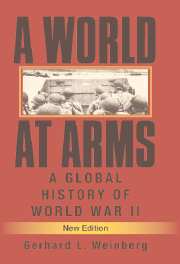Book contents
- Frontmatter
- Dedication
- Contents
- List of Maps
- Preface to the New Edition
- Preface to the First Edition
- List of Abbreviations
- Introduction
- 1 From one War to Another
- 2 From the German and Soviet Invasions of Poland to the German Attack in the West, September I, 1939 to May 10, 1940
- 3 The world Turned Upside Down
- 4 The Expanding Conflict, 1940-1941
- 5 The Eastern Front and a Changing War, June to December, 1941
- 6 Halting the Japanese Advance, Halting the German Advance; Keeping Them Apart and Shifting the Balance: December 1941 to November 1942
- 7 The War At Sea, 1942-1944, and the Blockade
- 8 The War in Europe and North Africa 1942-1943: to and from Stalingrad; to and from Tunis
- 9 The Home Front
- 10 Means of Warfare: Old and New
- 11 From the Spring of 1943 to Summer 1944
- 12 The Assault on Germany from All Sides
- 13 Tensions in Both Alliances
- 14 The Halt on the European Fronts
- 15 The Final Assault on Germany
- 16 The War in the Pacific: From Leyte to the Missouri
- Conclusions: the Cost and Impact of War
- Bibliographic Essay
- Notes
- Maps
- Index
Introduction
Published online by Cambridge University Press: 05 February 2014
- Frontmatter
- Dedication
- Contents
- List of Maps
- Preface to the New Edition
- Preface to the First Edition
- List of Abbreviations
- Introduction
- 1 From one War to Another
- 2 From the German and Soviet Invasions of Poland to the German Attack in the West, September I, 1939 to May 10, 1940
- 3 The world Turned Upside Down
- 4 The Expanding Conflict, 1940-1941
- 5 The Eastern Front and a Changing War, June to December, 1941
- 6 Halting the Japanese Advance, Halting the German Advance; Keeping Them Apart and Shifting the Balance: December 1941 to November 1942
- 7 The War At Sea, 1942-1944, and the Blockade
- 8 The War in Europe and North Africa 1942-1943: to and from Stalingrad; to and from Tunis
- 9 The Home Front
- 10 Means of Warfare: Old and New
- 11 From the Spring of 1943 to Summer 1944
- 12 The Assault on Germany from All Sides
- 13 Tensions in Both Alliances
- 14 The Halt on the European Fronts
- 15 The Final Assault on Germany
- 16 The War in the Pacific: From Leyte to the Missouri
- Conclusions: the Cost and Impact of War
- Bibliographic Essay
- Notes
- Maps
- Index
Summary
Although this book contains a chapter on the background of World War II, it defines that war as beginning in 1939 in Europe. While some have argued that the war was merely a continuation of World War I after a temporary interruption created by the armistice of 1918, and that the whole period from 1914 to 1945 should be seen as the age of a new European civil war, a Thirty-one Years War if you will, such a perspective ignores not only the very different origins and nature of the prior conflict but obscures instead of illuminating the special character of the second one. If an important by-product of both wars was the weakening of Europe and its hold on the world, the intentions of the belligerents were fundamentally different. It is true that these changed somewhat in the course of each of these lengthy struggles, but a basic differentiation remains.
In World War I, the two sides were fighting over their relative roles in the world, roles defined by possible shifts in boundaries, colonial possessions, and military and naval power. It is true that the Austro- Hungarian empire anticipated the elimination of Serbia's independent status, and Germany very quickly came to the conclusion that Belgium would never regain its independence, but beyond this expected disappearance of two of the smaller states which had emerged from larger constructions during the nineteenth century, the other powers—and most especially the major ones—were all expected to survive, even if trimmed by the winners. In this sense, the war, however costly and destructive in its methods, was still quite traditional in its aims.
It is also true that the fighting itself, with its unprecedented casualties, its incredible costs, the appearance of such new weapons as poison gas, airplanes, tanks, and submarines, as well as vast shifts in world economic patterns, ended up completely transforming the pre-war world and doing so in ways that none of the belligerents had anticipated.
- Type
- Chapter
- Information
- A World at ArmsA Global History of World War II, pp. 1 - 5Publisher: Cambridge University PressPrint publication year: 2005



